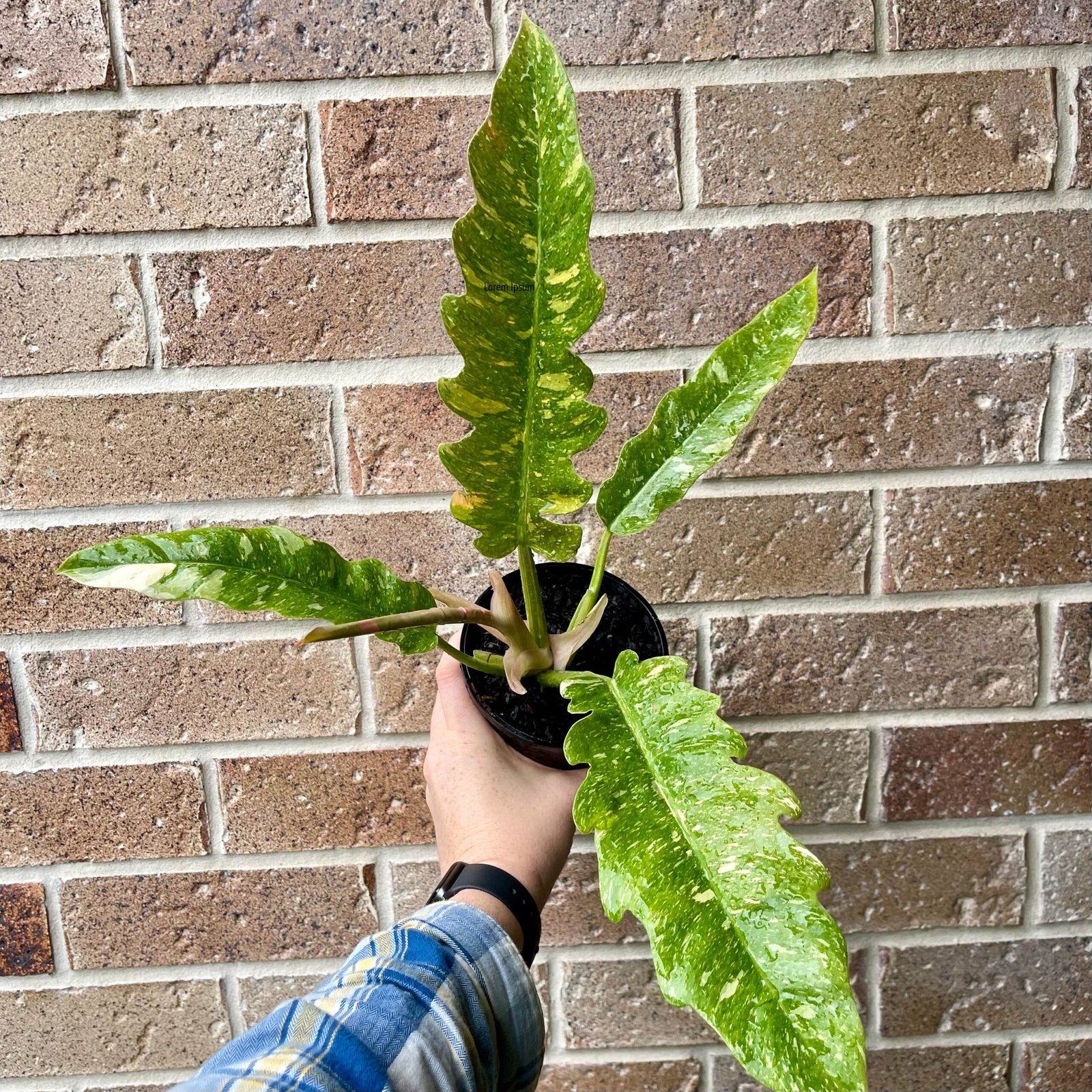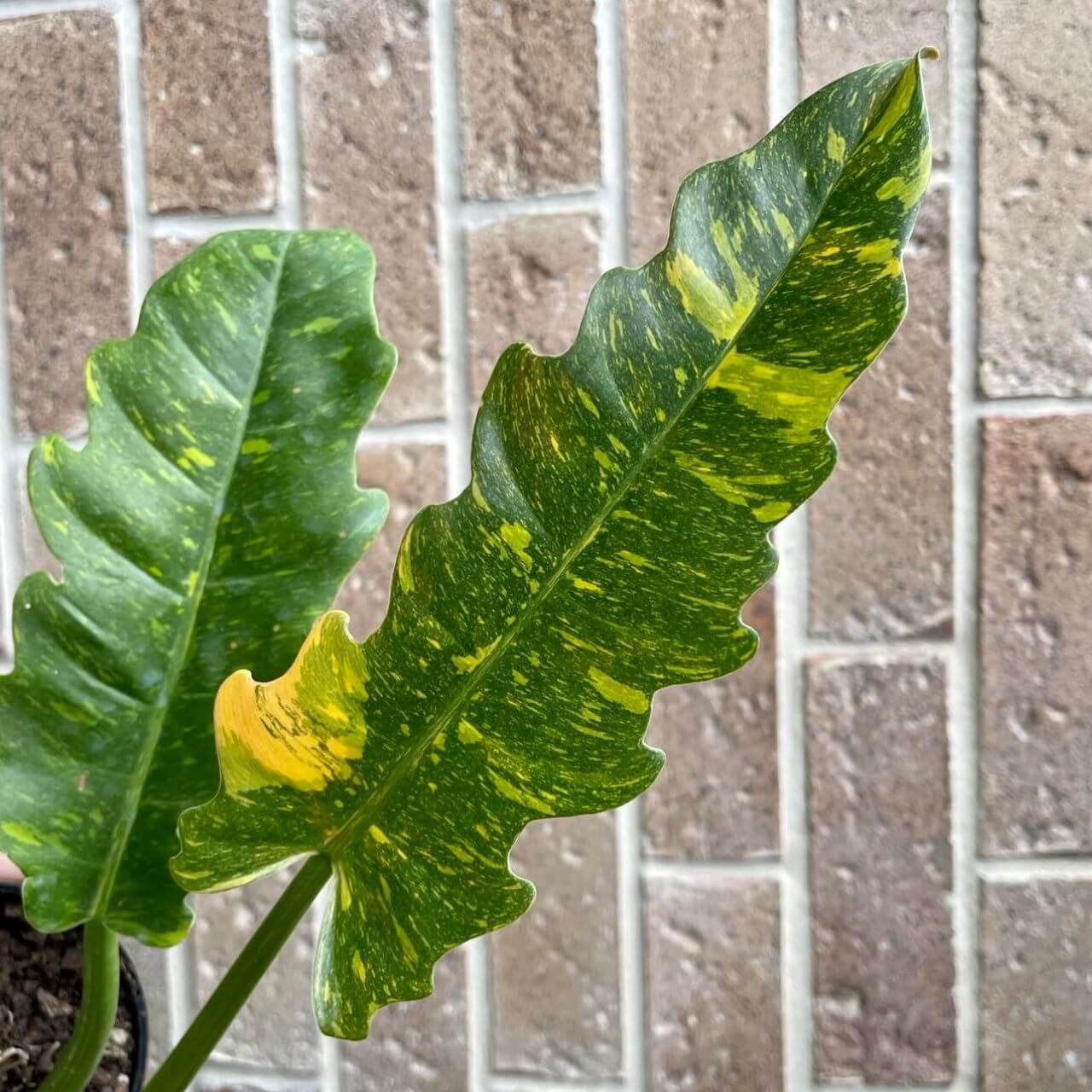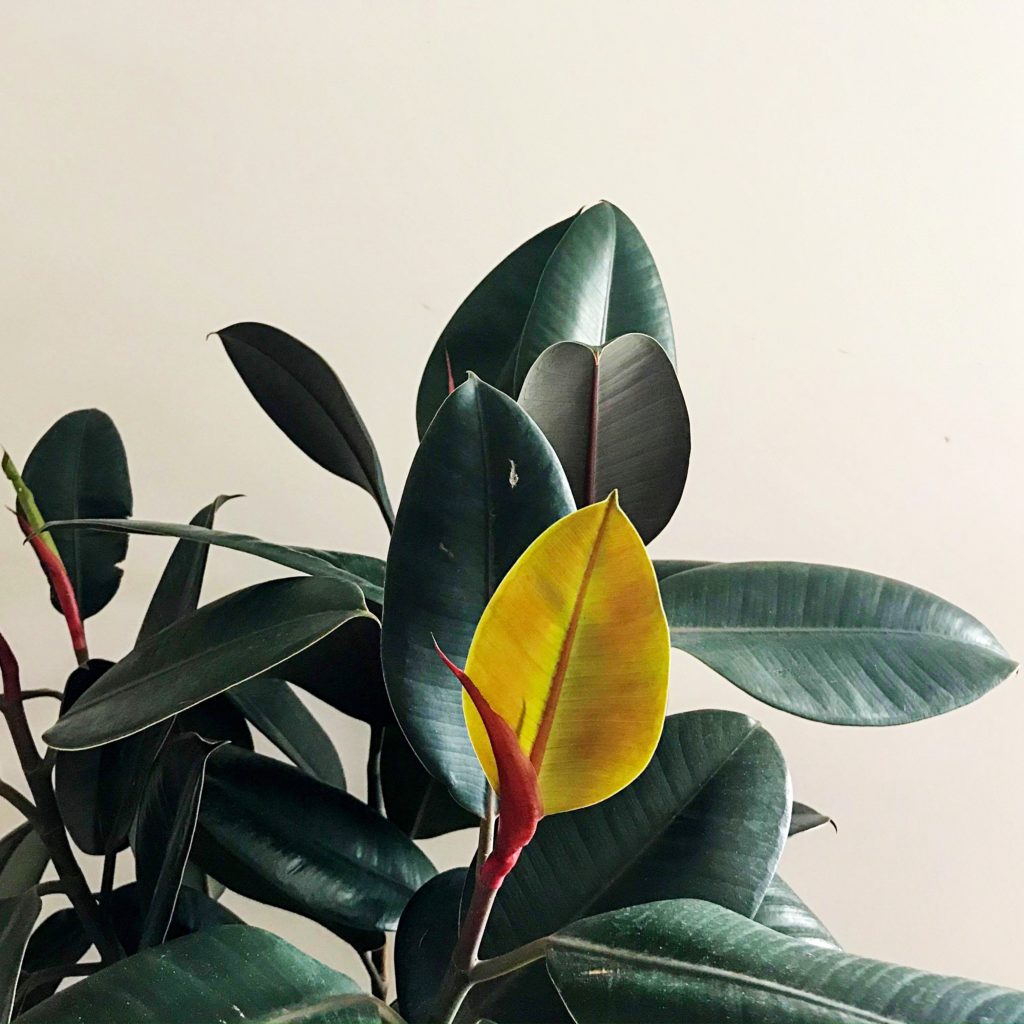The Philodendron Ring of Fire is a must have in your plant collection. It features long beautiful foliage with zagged edges with a mix of green, yellow, orange, white and red variegation. This Philodendron variety is a slow grower, but it is worth the wait once it matures. This plant is easy to care for when given bright indirect light, between 30%-50% humidity and well draining soil.
Philodendron Ring of Fire is part of the Araceae family and native to Central and South America. This plant is a hybrid of Philodendron Wendlandii and Philodendron Tortum. Like all Philodendron, this plant is toxic and should be kept away from pets and small children.

Philodendron Narrow Variegata a.k.a Philodendron Ring of Fire
Philodendron Ring of Fire Quick Overview
| Full Size | Up to 1 metre |
| Light | Bright indirect light |
| Temperature | 60ºF-80ºF (16ºC-26ºC) |
| Humidity | 30%-50% |
| Cost | $$ |
| Care Level | Easy |
| Toxicity | Toxic |
Size
The mature size of a Philodendron Ring of Fire is up to 1 metre (3.3 feet) in height. The leaves can grow up to 24 inches in length and 16 inches wide.
This plant is known to be quite a slow grower and won’t require much pruning. You can add a pole to the pot to help it climb and encourage larger leaves.
Light Requirements
Philodendron Ring of Fire will grow best when in bright indirect lighting. This plant can tolerate lower light conditions but if you want your plant to produce its bright fiery colours, it will need to positioned in a spot where it will receive brighter light.
You should try and avoid direct sunlight as this can scorch and discolour the foliage. Yellowing leaves can be a sign of too much sunlight.
A sign your Philodendron Ring of Fire isn’t receiving enough light is the plant becoming leggy. Moving your plant to a spot where it receives filtered sunlight will help keep your plant happy and healthy.
If your plant is housed in a spot where it receives direct sunlight, adding a blind or curtain to your window will help to defuse the harsh sunlight to avoid burning the plants foliage.
Alternatively, if you can’t seem to find that perfect spot in your home, you can always use grow lights. Just like direct sunlight, if your plant is sitting too close to the grow lights, they will burn the foliage. Keeping a safe distance of at least 60cm between your plant and the light will avoid any trouble.
Temperature
The ideal temperature for growing Philodendron Ring of Fire is between 60ºF-80ºF (16ºC-26ºC). This plant loves warmer temperatures and doesn’t tolerate cold temperatures.
Temperatures that reach much higher than 80ºF (26ºC) can cause heat stress, while temperatures that drop below 55ºF (12ºC) can cause stunted growth. Prolonged exposure to cold temperatures can lead to plant death.
During the cooler months, you should move your plant to a warmer spot in your home. You should also try and avoid fluctuating temperatures and cold drafts from doors, windows and air conditioning. This can cause shock and can cause the plant to wilt, discoloured leaves and/or leaf drop.
Roots that have rotted can no longer take in any water or nutrients to the plants which causes fungus issues, pest problems and root-rot. A sign that you may have over-watered your Ring of Fire are leaf drop and drooping and/or yellowing leaves.

Humidity
Philodendron Ring of Fire will thrive when kept in a humidity range between 30%-60%. If your plant is housed in a spot where the humidity level is too low, you may notice brown leaf tips. Humidity levels that are too high can cause brown leaves and fungus issues.
If your plant is housed in a spot with a humidity level consistently outside of this range it can lead to health issues and damaged leaves.
Providing humidity for your plants will encourage bigger and healthier growth. There are a few thing you can do that can help bump up the humidity in your home. The things you can try are:
- Misting your plants
- Pebble trays
- Grouping plants together
- Humidifier
See our tips for increasing humidity.
Watering Requirements
Philodendron Ring of Fire will require water at least once a week. This will change during the cooler months when the temperature and amount of sunlight changes.
Before watering, check the top 2-3 inches of soil with your finger to feel if it is still moist. If the soil is dry, you can give your plant some water. A sign that your Philodendron Ring of Fire is thirsty is wilting and curling leaves.
Philodendron Ring of Fire like to be kept in a soil that is kept slightly moist however, you need to be cautious of over-watering your plant. The excess water to the soil can cause it to become waterlogged which can cause the roots to start rotting as a result of not enough oxygen for the plants roots to breath.
Fertilizing requirements
You should fertilise your Philodendron Ring of Fire monthly during Spring and Summer. You can cut back on fertilising during the cooler months when the plant is no longer actively growing.
Fertilising your plants gives them the essential nutrients they need for promoting and maintaining new and healthy growth. Applying fertiliser when the plant isn’t actively using up the nutrients in the soil can cause salt build up and root burn.
The best fertiliser to use for Philodendron Ring of Fire would be a balanced all purpose fertiliser diluted to half strength. Slow release fertilisers are a great alternative to liquid fertilisers.
If you’re using a slow release fertiliser, you won’t need to give your plant fertiliser as often and the plant can take up the nutrients as it needs them. Slow growth and small leaves can be a sign that your Philodendron Ring of Fire isn’t getting enough light or fertiliser and pale leaves can be a sign that it’s not getting enough micronutrients such as magnesium and calcium.
Since this plant can be quite a slow grower, you need to be cautious of over-fertilising. Over-fertilising your Philodendron Ring of Fire can cause salt build up and burn the roots and foliage.
If you think you’ve over-fertilised your plant you can either change the soil or rinse the fertiliser out. The water colour will change once the fertiliser has been rinsed out.
Soil Requirements
Philodendron Ring of Fire like to be in a rich, well draining and aerated soil. To achieve a good well draining soil, you can use a mix of potting soil, orchid bark, peat moss, charcoal and perlite.
These help to create better drainage and aeration. Air flow is important in potting soil as it allows the plants roots to breath. Not having enough oxygen to the roots can cause them to eventually start rotting.
You can also add other ingredients like coco coir, coconut husk and mulch chunks to the soil to help restrain moisture. Philodendron Ring of Fire like to be kept in a moist soil so it’s important to use ingredients that will help hold moisture but not make the soil soggy.
Adding garden compost or worm castings to the soil will add more richness which this plant will love.
Repotting
Philodendron Ring of Fire doesn’t require frequent repotting, but here’s how to do it when the time comes:
- When to Repot: If the plant becomes root-bound or the soil looks exhausted, it’s time to repot. Typically, every 2-3 years is sufficient.
- Choose the Right Pot: Select a pot that’s 1-2 inches larger in diameter than the current one. Ensure it has good drainage holes.
- Preparation: Fill the new pot with a well-draining potting mix suitable for Philodendron.
- Remove the Plant: Gently remove the Philodendron from its current pot, shaking off excess soil and checking for any signs of root rot or pests.
- Planting: Place the plant in the new pot and fill around it with soil, pressing down gently to eliminate air pockets.
- Watering: Water the plant thoroughly after repotting to help it settle.
Diseases & Pests
The most common pests that you may encounter on your Philodendron Ring of Fire are spider mites, mealybugs, thrips, scale and aphids. The most common diseases your may encounter are root-rot, rust and Erwinia blight.
For a majority of the mentioned pests the best prevention is keeping a strong and healthy plant as this gives it the best fighting chance and immune system. For more information on treating common houseplant pests click here.
The best thing you can do when it comes to pests on houseplants is to try and avoid any pest infestations from starting. There are a few things you can do that will assist in preventing any pest infestations and these things are:
- Checking new plants for pests or isolating new plants for up to a week.
- Check your plants every few days for pests.
- Trim off any dead or dying leaves.
- Wipe down leaves if you notice them getting dusty.
- Keeping your plants healthy. A healthy plant will be able to handle an infestation better than those that aren’t as happy.
- Isolate any plants that have pests.
Following this will assist in keeping pests away as well as catch them early on before any severe infestations are able to start. Keeping plants healthy and in the correct living environments can help to deter any pests from invading your plants.
Toxicity
Philodendron Ring of Fire contain Calcium Oxalate Crystals which is toxic to both humans and pets if ingested. If any part of the plant is ingested, symptoms may include swelling of the oesophagus, GI tract and mouth.
If ingested by pets, the symptoms may include vomiting, lack of appetite, drooling and pawing at the mouth. Plant should be kept out of reach of small children and pets.



